- 408-924-7560
- mineta-institute@sjsu.edu
- Donate
Newsletter Vol. 21, Issue 1: Summer 2014
 Outstanding work gets results
Outstanding work gets results
Rod Diridon, Emeritus Executive Director
Rod Diridon
Emeritus Executive Director
MNTRC has just been notified by US DOT that the contracting period within which the current federal and matching funds may be expended has been extended to January 31, 2017. By that time, MNTRC will have compiled a very enviable benchmark record for the University Transportation Center program.
Since the Mineta National Transit Research Consortium (MNTRC) was established in January 2012, it has produced an impressive amount of work. The nine university members have collaborated to benefit the US, its transit services, and its riders. As a consortium, MNTRC has enjoyed a period of remarkable effort and unique success. The projects were selected after a national needs assessment with US DOT’s Federal Transit Administration, so they focus on current needs. The following is a “snapshot” of our successes using the MNTRC US Department of Transportation grant and matching funds.
MNTRC Research and Research Associates
- Research projects begun: 72
- Research published and publicized for use by the national transit community: 13
- Research reports in peer review, editing or printing: 19
- Research in progress to be completed in the next two years: 40
- Faculty Research Associates under contract: 111
- Student Research Assistants under contract: 164
MNTRC’s policy is that a research project is not completed until the product is peer reviewed, published, and is used by the transportation industry. Therefore, the following two-year outreach metrics are pivotally important.
MNTRC Outreach
- Formal presentations at professional conferences: 46
- Media interviews (not including repeat broadcasts): 132
- Summits and forums presenting MNTRC research: 36
- Attendance at MNTRC summits and forums: 3,845
- K-12 outreach programs (e.g., Summer Transportation Institutes and others): 9
- K-12 students attending MNTRC outreach programs: 367
- Two-year MNTRC/MTI web site visits: 8,124,336
- Two-year document downloads: 2,463,984
Note that this litany does not cover the continuing formal degree programs, which each university continues to present and in which the students number in the many thousands. Compliments and congratulations to every MNTRC Center director, staff, researcher, and student!
The MNTRC Annual Report is now available for download.
PROFILE
MNTRC welcomes Dr. Karen Philbrick as new Executive Director
by Donna Maurillo, Director of Communications & ITT
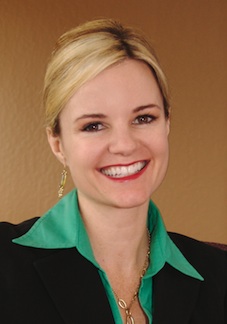 The Board of Trustees, San Jose State University leaders, researchers, professors, and staff celebrate the selection of Dr. Karen Philbrick to lead the Mineta National Transit Research Consortium (MNTRC) and the Mineta Transportation Institute (MTI). Dr. Philbrick assumed the executive directorship on July 1, as Rod Diridon, the Institute's executive director since 1993, shifted to emeritus status. Dr. Philbrick also will continue to fulfill her critically important role as director of research for both agencies, overseeing more than 50 projects currently in process and more than 200 research associates and 150 student research assistants under contract.
The Board of Trustees, San Jose State University leaders, researchers, professors, and staff celebrate the selection of Dr. Karen Philbrick to lead the Mineta National Transit Research Consortium (MNTRC) and the Mineta Transportation Institute (MTI). Dr. Philbrick assumed the executive directorship on July 1, as Rod Diridon, the Institute's executive director since 1993, shifted to emeritus status. Dr. Philbrick also will continue to fulfill her critically important role as director of research for both agencies, overseeing more than 50 projects currently in process and more than 200 research associates and 150 student research assistants under contract.
Former Secretary Norman Mineta said, “I have never met such a dynamic, young individual possessing the intellect and maturity of Dr. Philbrick. We are all excited to have her assume the leadership of the Mineta Institute team.”
Dr. Philbrick was recruited by MTI five years ago for the challenging position of MTI research director. Two years later she was promoted to deputy executive director. Previous experience as a counseling and research psychologist, coupled with more recent research administration success, prepared her to transition quickly into leadership at MTI.
Prior to joining the MTI team, Dr. Philbrick was assistant director of the National Center for Intermodal Transportation at the University of Denver where she conducted and guided numerous research projects. For a study on operator fatigue, she interviewed thousands of locomotive engineers and conductors, as well as airline pilots, maritime industry representatives, and truck drivers. Her work was the foundation for an international training seminar “Innovations and Challenges in Intermodal Transportation” delivered in the Philippines and Indonesia. She has been a member of the US delegation of the Asian Pacific Economic Cooperation (APEC) Transportation Working Group since 2000. More recently, she was appointed by former US Secretary of Transportation Ray LaHood to the US Department of Transportation Transit Rail Advisory Committee for Safety (TRACS). In 2013, she was elected to the prestigious Executive Committee of the national Council of University Transportation Centers (CUTC).
Dr. Philbrick will work closely with the MNTRC/MTI Board of Trustees, which includes 25 world-class leaders in surface transportation. MTI Trustees Chair Steve Heminger, Executive Director of the San Francisco Area Metropolitan Transportation Commission, said, “Karen Philbrick represents all that is good in our rapidly emerging younger generation and will do a fine job leading MTI and MNTRC. Her drive for excellence is recognized by all with whom she associates.”
Dr. Philbrick earned her PhD from the University of Denver after earning a BA from California State University, Fresno, and an MA and EdM from Columbia University.
Since arriving at MTI, she has directed the three subcenters and more than 100 principal investigators. She has overseen the competitive selection of 122 new research projects, as well as the publication and distribution of more than 150 peer-reviewed research reports. Emeritus Executive Director Rod Diridon said, “Karen is a collegial mix of competence and tenacity and a charismatic force of nature. She’ll carry MTI to new heights of excellence.”
How can public-private partnerships help transit agencies?
Hokey Min, PhD, James R. Good Chair in Global Strategy
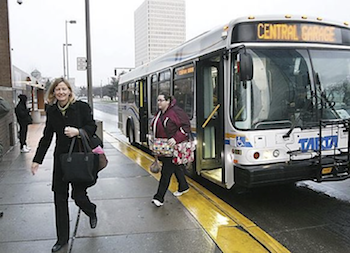
Many people use TARTA buses to access jobs, shopping, and services.
BOWLING GREEN STATE UNIVERSITY NEWS – Thanks to high gasoline prices and stifling traffic congestion, more city dwellers are riding transit. That demand has put pressure on transit agencies to expand routes, improve infrastructure, and hire more workers. But those things are costly, especially in a time of government cutbacks and budget reductions. This means agencies must increase their financing options without burdening taxpayers or government. Can public-private partnerships (PPP) help fill that gap? It’s already being tested in the Toledo area.
To increase a ridership among three target customer bases (work commuters, shoppers, and disabled individuals), Toledo Area Regional Transit Authority (TARTA) realized it should offer more customized transit services (e.g., customer-friendly routes and schedules), modernize its equipment and facility, and retain/recruit good drivers. All this requires adequate financing and investment. Various factors led TARTA to consider a PPP model.

Partnering with Kroeger helped TARTA fund bus rides for grocery shopping.
It started with two supermarkets
Here’s how it works. A list was made of all major businesses and services along TARTA routes. These would be potential partners. Among this list, two grocery chain stores recently formed a partnership with the TARTA, which can be a template for the formation of other PPPs. Given that the six branch locations of Kroger and the five branch locations of Meijer were on the current TARTA routes, TARTA agreed to promote both Kroger and Meijer stores with a slogan stating, “Shop at Kroger/Meijer ride with TARTA for free!”
In returning favor to TARTA, both Kroger and Meijer pay an annual fee to advertise their logos on the side of the circulator. This fee helps TARTA defray the costs of bus maintenance, repair, and crews. This partnership arrangement created a win-win outcome (i.e., greater publicity and revenue) for both parties. For example, Kroger and Meijer customers were given more incentives to ride with TARTA while allowing them to shop at supermarkets that they like. A similar partnership is under development with St. Luke Hospital to increase patient visits via TARTA buses.
Incentives are an effective catalyst for PPPs
Agencies that wish to follow this example could develop their own incentives such as transit schedules and routes tailored toward the locations and working hours of partnering private businesses; free ride or reduced fare for the customers and employees of those businesses; fostering a positive public image of the businesses that give donations and sponsorships; and potential tax credits or abatements.
To make these incentives an effective catalyst for PPPs, the transit authority should first specify the minimum eligibility to consider these incentives and then determine which incentives should be offered to which private businesses. Also, once PPP agreements are reached by sides, they should clarify specific contract provisions regarding expected PPP outcomes, cost sharing between the transit authority and its private partner for transit service improvement, rules for dealing with unforeseen events and defaults, and conflict resolution mechanisms.
The future could hold more opportunities
Currently, the TARTA’s PPP incentives are limited to free ride and advertisement for partnering private businesses such as supermarket chain stores. To create more PPP opportunities, the TARTA could target a greater pool of private enterprises benefiting from the TARTA services such as the locally-based corporations (e.g., Owens-Illinois, Campbell Soup, Ford, Chrysler) with a larger number of employees and multiple shifts.
To properly monitor the progress of PPPs and minimize wasteful resource allocation, a systematic and periodic evaluation process should be in place. These could include considering the PPP performance criteria aligned with the mass transit service goals; establishing a performance management system; and developing feedback mechanisms and corrective actions.
Anyone interested in the full paper can reference “Public-private partnerships for improving the regional mass transit system: a case study of the Toledo Area Regional Transit Authority,” International Journal of Logistics Systems and Management, Vol. 17, No. 2, pp.160–179.
Battery recovery helps keep transit sustainable
Charles Standridge, PhD, Professor and Assistant Dean

Layout of a disassembled lithium iron phosphate cell with an unopened cell.
GVSU NEWS – Battery recycling is essential, as eventually all cells in all batteries will fail to hold a charge sufficient for any application. This means cleanly separating and thus recovering copper, aluminum, iron phosphate, and lithium from lithium iron phosphate batteries. Because these batteries are relatively new on the market, there are no studies about their recycling. Thus, laboratory-scale experiments were designed and conducted at Grand Valley State University’s (GVSU) School of Engineering based on a review of previous studies about lithium cobalt oxide batteries.
Acid leaching was identified as the most popular method for extracting raw materials from these batteries. Methods of disassembly are specific to each battery type due to differences in packaging, structure, and components. In this case, disassembly equipment included a glove box with fume hood and air pump, a utility knife, and a sheet metal cutter.
Four layers are contained within the jellyroll that comprises the cell beneath the outer cover. These include aluminum foil coated with lithium iron phosphate, copper foil coated with graphite, and the other two separator membranes with electrolyte residue on them. At the center of the jellyroll was a stainless steel tube.
To successfully separate the coatings from the copper and aluminum foils, we performed acid leaching using nitric acid for aluminum and sulfuric acid for copper. The experiments were conducted at various temperatures ranging from 33-60 degrees centigrade. The material was exposed to the acid for either one or two minutes. Additional validation of the recycling process will be attempted on batteries from other manufacturers.
Recycling in isolation is not economical because lithium-ion (li-ion) batteries are composed of relatively inexpensive materials. However, recycling can support closed-loop supply chains reusing materials from end-of-application batteries in the production of new batteries as well as supporting environmentalism and sustainability. Economically, the need to recycle must be supported by original, remanufacturing, and repurposing applications.
Faculty members, graduate students, and staff from GVSU’s School of Engineering are continuing research activities regarding the remanufacturing, repurposing and recycling of li-ion batteries from transit vehicles such as buses. This work is performed in partnership with Sybesma’s Electronics, a third-generation family owned business in Holland MI to insure that it has industrial applicability. The project’s overarching goal is to provide better economic value to transit operators who use electric vehicles and thus increase public transit’s sustainability.
Alternatively fueled vehicles show range of technologies
David J. Klinikowski, Director, Center for Bus Research and Testing

Featured vehicles included electric motorcycles.
PENN STATE NEWS – The Thomas D. Larson Pennsylvania Transportation Institute’s Hybrid and Hydrogen Vehicle Research Laboratory hosted the 21st Century Automotive Challenge at Penn State’s University Park Campus on April 10-13. Participating vehicles represented a broad range of automotive power choices, including electric, gasoline-hybrid electric, pluggable hybrid electric and biodiesel. Many types of advanced alternative fuel vehicle technologies have been designed, built, and researched at Penn State, which has infrastructure for various means of fueling.
On Thursday and Friday, April 10-11, competition vehicles registered for two days of preliminary technical inspection, dynamic testing, range events, and student and faculty tours.
Interconnectivity proved important
The following day, all competition vehicles plus other vehicles of interest were displayed at Penn State’s MorningStar Solar Home. Visitors could ask questions and talk with competition participants during the display event. Participants ranged from the hobbyist to the entrepreneur, and from a team of high school students to current market vehicles.
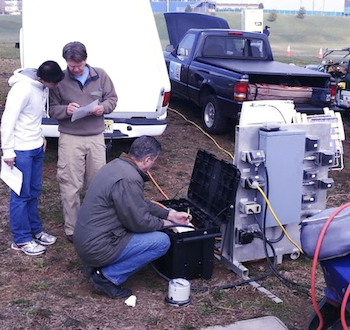
High school teams also participated.
The 21st Century Automotive Challenge partnered with Penn State’s Sustainability Institute to integrate vehicle-to-building (V2B) and vehicle-to-grid (V2G) technology into the competition format between competing vehicles and the center's award-winning MorningStar Solar Home.
This competition format demonstrated the reality of car, grid, and home interconnectivity, which is especially pertinent with the market emergence of production pluggable electric and hybrid cars.
Penn State has the infrastructure for testing
With vehicles representing a range of advanced technologies, the competition events included inspection and dynamic tests as well as travel scenarios representing a busy day of errands and a day of leisure travel. Participants included teams from the former American Tour de Sol Electric Vehicle Championship and the Eastern Electric Vehicle Club (EEVC). Scoring officials included professionals representing Penn State engineering alumni, Penn State’s Department of Energy-sponsored Graduate Automotive Technology Education (GATE) Program, Central Pennsylvania Institute of Technology, and the local racing community.
It was exciting to center this competition in Penn State's domain, where many types of advanced alternative fuel vehicle technologies have been designed, built, and researched, and where infrastructure for various means of fueling exist.
Among the competing vehicles were a Chevy Malibu ethanol HEV, a Saturn Vue biodiesel HEV, a Citroen Deux Chevaux EV, a Chevy S10 EV, two biodiesel Volkswagen Jettas, a 2013 Zero S electric motorcycle, a Biodiesel bread truck science display, and several others.
New York MTA’s early years reveal politics of finance
Nicholas Tulach, PhD Candidate, Rutgers University
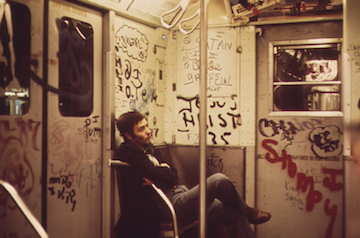
Heavily tagged metro vehicles can use significant maintenance funds.
Photo Credit: Erik Calonius, US National Archives
RUTGERS NEWS – Public transit finance is often examined from an economic perspective. Instead, research conducted by doctoral candidate Nicholas Tulach examines the politics of finance through a case study of the New York Metropolitan Transportation Authority (MTA). This ongoing historical study situates the narrative within a context of crisis management. It also further examines the intersection of actor-based history and structural forces to draw out the complexity of transit finance in America’s largest metropolitan region.
Financial trouble from the start
The study begins by examining the roots of financial trouble, which were present even at the agency’s founding. Originally created by Governor Nelson Rockefeller in 1965 as a way to save the region’s struggling commuter railroads, the MTA was expanded in 1968 to include the New York City Transit Authority, which operated the subway and bus systems, and the Triborough Bridge and Tunnel Authority, the last piece of Robert Moses’s New York infrastructure empire. Though Rockefeller’s vision was to use bridge and tunnel tolls to fund public transit and embark on a major expansion program, political battles over the transfer of suburban driver tolls to city transit users threatened to undo the delicate fiscal arrangement the governor had concocted.
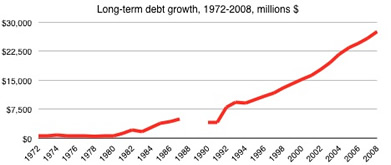
Long-term debt growth, 1972-2008
Data Source: MTA Annual Reports, 1972-2008
By the end of the 1960s, all the MTA’s various component agencies struggled to maintain and operate their existing systems. Rockefeller and William Ronan, chairman of the MTA, continued their ambitious vision of system expansion despite the agency’s significant needs for additional operating and maintenance funds. One such project was the Second Avenue Subway, which would take nearly 50 years to revive.
Flagging support from city and state
The 1970s were a decade of total economic transformation for older American cities. Deindustrialization and suburbanization accelerated, with the former primarily responsible for the decline in many high paying, low skilled jobs in the city center. Industry began to relocate outside the city or to move out of the United States completely. Not only did the role of public transit in the daily lives of New Yorkers begin to change, but the system itself struggled to maintain sufficient ridership. Subway ridership declined from a post-war peak of more than 2 billion passenger trips to fewer than 1 billion by 1976.
At the same time that ridership declined, state and city subsidies also declined. This was the era of New York history forever immortalized by the New York Post headline, “Ford to City: Drop Dead.” While the MTA struggled to operate and maintain the vital regional transportation infrastructure, the City and State of New York teetered at the edge of bankruptcy. Retrenchment was seen as the only option for agencies and public authorities. So while the leadership of the MTA knew it needed increased funds to repair a crumbling system, they were asked to make further cuts as part of a broad public spending reduction.
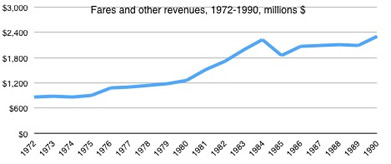
Fares and other revenues, 1972-1990
Data Source: MTA Annual Reports, 1972-2008
Retrenchment is poor policy for failing public infrastructure, which by its nature as a public good cannot be supported by the private marketplace and, therefore, must be subsidized. Where those subsidies come from—paid for by users or commonly shared among a broader population—is a legitimate political question. However, cutting infrastructure funding during periods of austerity leads to further crisis and decline. This was the outcome of mid-1970s public finance in New York, and the MTA’s infrastructure—already in deplorable condition—quickly degraded. In turn, this led to a spiral of ridership loss and further fiscal trouble. The long-managed fiscal crisis had finally become too much to handle by simple last-minute budget fixes alone.
“State of Good Repair” political and financial fix
By 1979, the MTA’s problems had become such a public spectacle that they could no longer be ignored by Governor Hugh Carey. He reached out to an unusual choice to help turn around the troubled agency, but it was one he knew was likely to succeed. Richard Ravitch, a friend of the governor and long-time public servant with a background in real estate, was asked to take over the chairmanship position and correct the agency’s many problems. The troubles had gone 1970s version of viral, with derailments, fires, graffiti, and robberies on the subways appearing almost daily in newspapers and on television.
Ravitch immediately identified that the troubles of the agency were tied, first, to a lack of sufficient revenues to cover operations and maintenance and, second, to a misguided allocation of resources to capital expansion projects instead of to maintenance. He created a new policy to address these misallocations and called it “State of Good Repair.” Resources no longer would be squandered on expansion projects. Instead, they would be directed at a prioritized list of maintenance projects. To finance his ambitious goals, the MTA would need new revenues. Without state and city support for increased subsidies, Ravitch knew his only option was to increase fares. Fares, however, had been a long-standing political fiasco for city and state politicians, who often staked their political careers on maintaining the existing subway fares. Ravitch, however, was enabled by the governor to explore fare increases, and he used his background in real estate finance to open a new avenue to address this issue.
Financial independence at last
Ravitch and his advisors thought if they could borrow against farebox revenue, they could raise enough capital to tackle the massive repairs that were necessary to restore the system. The state could not provide the subsidies directly, but the agency could raise short-term capital if there were a way to convince the banks that MTA gross revenue bonds were a reasonable investment. Ravitch commissioned a study from Charles Rivers Associates to provide justification for these new debt instruments—that the agency would be able to support itself with fare increases and service cuts alone if subsidies were to disappear.
Creating the gross revenue bonds also operated on the assumption that fare increases would become a consistent, predictable component of long-term transit finance. This was a major departure from fare politics of the previous 50 years, in which fare increases were politically unfeasible and fares were held as low as possible. Ravitch was the first chairman to achieve the kind of independence that was envisioned at the creation of the MTA.
Gross revenue bonding had not been done before, and if it were to be successful, the MTA would need support from outside the agency. Ultimately, the agency found that support from private investors and was able to raise enough revenue to begin its program of repairing the transit system.
New era of debt finance
Gross revenue bonds ushered in a new era of debt financing that allowed the MTA to solve its short-term capital deficiency and constitute a new program aimed at righting long-standing shortfalls in system maintenance. By most accounts, the agency was successful. They were able to clean their subway cars, repair their public image, and decrease crime and the perception of crime in the system. Ultimately, the MTA would see ridership gains and other technological improvements such as the MetroCard fare payment system that would lead to even greater gains.
Yet the cost of this repair continues to haunt the agency. In 2008, the MTA saw losses totaling at least $5 million related to derivatives it had created similar to the real estate financial crisis. The agency’s finances are vastly more complicated and difficult to forecast than before, leading to a continuous reliance on debt financing to cover shortfalls over the years. The MTA still has not solved its financing issue, but instead it has managed to push off the problems associated with underfunding to future generations through ever more complex financing arrangements. Until the political will to fully fund public transit is found in New York, the MTA will continue to struggle with these issues.
San Jose State University News
Research
Terrorism database yields valuable insights
Karen Philbrick, PhD, Executive Director
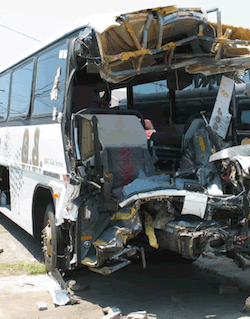
Aftermath of terrorist bus bombing.
The very qualities that make public transit efficient—the ability to move large numbers of people through populous areas at minimal cost—also make it a highly attractive target for terrorists. From September 11, 2001 to December 31, 2013, terrorists carried out approximately 2,515 attacks against public surface transportation worldwide, resulting in 5,220 deaths and 17,106 injuries.
Since 1996, the MTI National Transportation Safety and Security Center (NTSSC) has maintained a secure, proprietary database known officially as the MTI Database on Terrorist and Serious Criminal Attacks against Public Surface Transportation. The database—which is not accessible by the public for security reasons—currently contains data on 4,139 attacks against surface transportation worldwide.
The NTSSC performs quantitative analyses of the data, enabling the NTSSC to detect subtle patterns and trends in terrorist tactics, weaponry, motives, and targeting processes. The NTSSC additionally examines detailed case studies of actual incidents. The insights that emerge help identify best practices and strategies to prevent or halt future attacks.
NTSSC performs research in five key areas:
- Threat analysis
- Security policy and procedures
- Disaster planning and emergency management
- Safety policy and procedures
- Security, safety, and emergency-response training development
In January, MTI began publishing policy briefings that contain insights based on the data; five have been published to date. Written by security experts, these Transportation Security Perspectives are available to the public at no charge on the MTI website.
Public transportation a high-value target
The following are some of the insights acquired through the database and discussed in the Transportation Security Perspectives:
- When body count is the objective, public surface transportation provides an attractive target, offering crowds of people in a confined environment.
- While suicide bombers can be lethal, more explosives can be packed into a vehicle left at the target site. These can be triggered remotely or even long after the attacker has left the area.
- Russia is among the primary killing fields in attacks against public surface transportation. This contradicts the general belief that only developing nations are targeted.
- Worldwide, 5.1 percent of these attacks occur in Russia, just behind Israel with 5.3 percent. Only India, Pakistan, and Columbia have more.
- Buses, trains, and subways that provide multiple access points (vs. airlines, for example) are more difficult to secure, thus they are targeted more often.
- Subways offer easy access and crowds of potential victims.
- Bombings during rush hours were a preferred course of action, and plotters can obtain information from readily available public sources and conduct their own reconnaissance.
Details of several terrorist plots are discussed in MTI’s free report, Carnage Interrupted: An Analysis of Fifteen Terrorist Plots against Public Surface Transportation.
Transportation security handbook fills critical void
Download the handbook free at the MTI website.
A transportation emergency training handbook by MTI research associates Dr. Frances Edwards and Mr. Dan Goodrich has received an overwhelming response from the transportation community. Written specifically for transportation sector organizations, Exercise Handbook: What Transportation Security and Emergency Preparedness Leaders Need to Know to Improve Emergency Preparedness offers the first comprehensive guidance to develop a Homeland Security Exercise and Evaluation Program (HSEEP)-compliant exercise cycle.
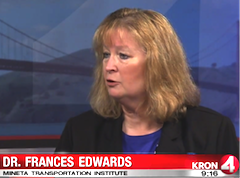
Dr. Frances Edwards, co-author of the transportation emergency preparedness handbook.
The first section is a research report that explains the evolution of the Department of Homeland Security’s (DHS) guidance and policies for the development of disaster preparedness. It includes the first complete analysis of the changes to homeland security implementation arising from Presidential Policy Directive-8 (PPD-8), and the issuance of the new frameworks for all phases of emergency management.
Practice exercises, real-world scenarios, expert advice, resources, and information kits
The second section is a comprehensive exercise handbook for the transportation sector. It is the first publication to provide transportation-specific exercise checklists, potential exercise objectives, and scenarios for each type of exercise, based on emergencies that have actually occurred. Also included are a complete set of home and personal preparedness materials for transportation workers and their households. The bibliography includes URLs for HSEEP, DHS and FEMA resources.
The handbook has received a great deal of media attention and positive feedback. MTI was notified that a portion of the handbook was used for training 7,000 participants from across federal, state, and local governments this past March. The report can be downloaded at no charge from the MTI website. A Microsoft Word version of the exercise handbook can be downloaded separately and customized as needed.
Information & Technology Transfer
Demand for MTI research stronger than ever
Donna Maurillo, MSTM, Director of Communications & ITT
MTI researchers and staff strive to produce high-quality research, but we do not count our efforts a success until we know the research is being read by those who can use it to serve the public good. To that end, we promote each publication through publicity campaigns that include nationally distributed news releases and social media campaigns, and we notify the news media of interview opportunities with MTI experts in areas of topical interest.
By analyzing activity and downloads on the MTI and MNTRC websites, we can see how well we've done. We're pleased to report that traffic on the MTI and MNTRC websites has risen significantly over the past year. For calendar year 2013, average monthly uses rose to 382,125—an increase of 29 percent over the previous year—and average monthly downloads increased by 9 percent to 106,829.
Some of our most recently released research includes:
- Transportation Futures: Policy Scenarios for Achieving Greenhouse Gas Reduction Targets
- Perceptions of Bicycle-Friendly Policy Impacts on Accessibility to Transit Services: The First and Last Mile Bridge
- Exercise Handbook: What Transportation Security and Emergency Preparedness Leaders Need to Know to Improve Emergency Preparedness
- A Study of Factors that Inhibit and Enable Development of Sustainable Regional Transit Systems in Southeastern Michigan
For a complete list of publications, visit the MTI and MNTRC web sites.
Communications
Women in Transportation meet in Denver
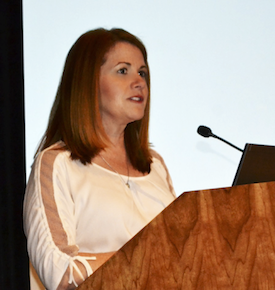
Louisiana Secretary of Transportation Sherri LeBas discussed her career in civil engineering.
In early April, the Mineta Transportation Institute (MTI) and the University of Denver’s National Center for Intermodal Transportation (NCIT) were among the co-sponsors of Women in Transportation: Recruitment, Retention & Advancementt. The summit, which took place in Denver, attracted a stellar roster of speakers, including Sherri LeBas, Louisiana Secretary of State, who delivered the opening keynote.
Secretary LeBas revealed that her civil engineering professor in college told her to leave the field, but she and ten others in her class stuck with it. Eventually she was inducted into the Louisiana State University Hall of Fame. She encouraged the audience of both men and women to commit themselves to public service and to ask what they can do to improve lives.
MTI’s new Executive Director, Dr. Karen Philbrick, said the first time she went to make a professional presentation, she was asked to get the coffee. “It was a real eye-opener,” she remarked. “Now at MTI, we’re very active in workforce development, starting in grade school and moving into high school and college.”
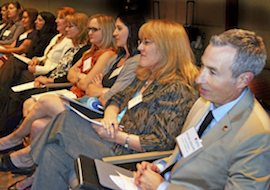
Attendees came from across the country to participate in the summit.
Marcia Ferranto, CEO of the Women’s Transportation Seminar, delivered the closing keynote. She cited a surprising statistic—that companies with women in top positions tend to perform much better—but she also noted that only 4.6 percent of companies have them, and only six women lead state DOTs. She pointed to a looming worldwide shortage of transportation workforce. “We must let women know that transportation is a viable career choice and includes many professions beyond engineering and operations—anything necessary to run a business, such as accounting, marketing, and human resources.”
Other speakers included Adriene Bailey, VP of Strategic Business Development at Yusen Logistics; Michelle Livingstone, VP Transportation, Home Depot; Anita Doney, Sr. Manager, International Logistics, Walmart; Marie Lacertosa, SVP, Supply Chain Management, JCPenney; Natalie Purnam, VP, Integrated Marketing, Ryder Systems; Kathy Waters, VP Member Services, APTA; Pauletta Tonilas, Director, Public Information, RTD-Denver; Polina Raygorodskaya, CEO, Wanderu; Ann Drake, CEO, DSC Logistics; Kelly Kinnebrew, PhD, Senior Consultant, Center for Creative Leadership; and Jill Hough, PhD, Director, Small Urban & Rural Transit Center, North Dakota State University.
Study reveals perceptions of transit
Leo E. Hanifin, PhD, Professor, Department of Mechanical Engineering
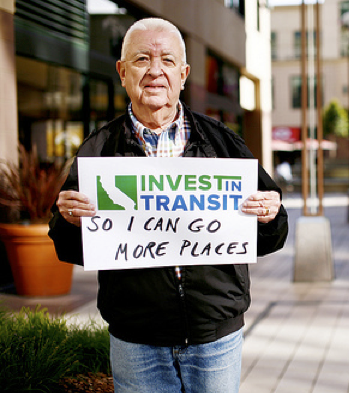
Transit is a primary means of mobility for many.
UNIVERSITY OF DETROIT MERCY NEWS – Before a transit agency can create solutions to perceived problems, it must understand what people think. The University of Detroit Mercy (UDM) presented the results from “A Study of Public Opinion Regarding Transit” at a conference in New Orleans on May 29. This study represents an intersection of two areas. These are public perception/sociodemographic studies in relation to transit, and transportation planning and design.
Among the key factors for effective public participation processes, The Transportation Planning Process Key Issues report by the Federal Highway Administration (FHWA-HEP-07-039, 2007) lists educating the public on transportation issues, identifying techniques for engaging the public, and defining methods to measure the participation program’s effectiveness.
Other studies highlight the limitations in current public participation efforts (e.g., Bailey and Grossardt, 2006) and indicate new trends for public participation in transportation planning (e.g., Innes and Booher, 2000), including interactive and collaborative methods.
Understanding the rider is key
In Trends Affecting Public Transit Effectiveness (Hemily, 2004), a study prepared for the American Public Transportation Association, the author specifically refers to the increasing underrepresented populations and why it’s important to consider their needs for mobility and to provide access to jobs for low-income groups. The complex and shifting contemporary transit landscape calls for a comprehensive study investigating the perceptions and beliefs regarding transit and planning initiatives for defining best practices for transit educational public opinion efforts and, broadly, for improved planning processes.
UDM’s study investigated public knowledge, opinions, and attitudes toward transit in southeastern Michigan, especially understanding the differences in perceptions and beliefs of diverse population groups in the region. The study included the design, administration, and analysis of a comprehensive public opinion survey (800 respondents), including automated call and online surveys. Public opinion was measured in relation to travel behavior and transportation priorities, to willingness to support transit and improve its sustainability, and to perceived benefits and negatives of transit initiatives.
Policy makers benefit, but so do riders
Findings highlight the political nature of transit issues, as well as the impact of ethnicity, educational levels, and urban contexts on perceptions and priorities. Results led to increased understanding of key issues connected to public opinion of transit and to development of a set of recommendations for effective education about transit. Findings benefit policy makers, planners, community designers, transit agencies, and transit advocacy groups. Ultimately, they will benefit riders, as well.
The report was authored by Claudia Bernasconi, Xiaohui Zhong, and Leo Hanifin, who will present the results.
-
Contact Us
San José State University One Washington Square, San Jose, CA 95192 Phone: 408-924-7560 Email: mineta-institute@sjsu.edu







